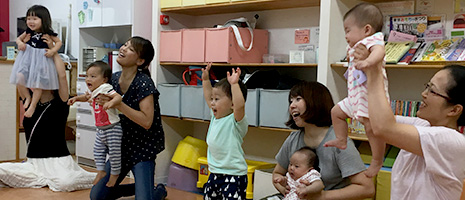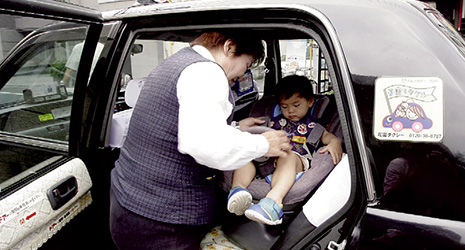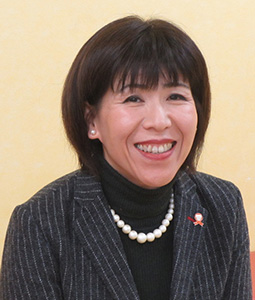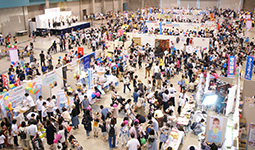Home > Highlighting JAPAN > Highlighting Japan February 2018 > Revitalizing the Regions
Highlighting JAPAN


A Network of Mothers Inspires
A child care group established by one mother twenty years ago is now spearheading the creation of a society that enables everyone to raise children with ease by actively collaborating with companies and administrative bodies.
Kagawa Prefecture, located on the island of Shikoku facing the Seto Inland Sea, is the smallest of Japan’s forty-seven prefectures, having a land area of about 1,877 square kilometers. As in other outlying regions of Japan, Kagawa Prefecture is experiencing the trend of weakening social ties in its communities, largely brought about by the concentration of the population in urban areas. Takamatsu City, the Kagawa prefectural capital, is a key location in Shikoku. Many companies headquartered in Tokyo and Osaka have established branches in Takamatsu, and families frequently relocate to the city as a result of job transfers. However, such relocations can make mothers with infants feel isolated in a city with which they are unfamiliar.
The specified nonprofit organization Wahaha Net was established by Emiko Nakahashi, who experienced difficulties herself when she relocated to Kagawa Prefecture while raising children. She leads social activities that attempt to resolve the concerns and worries of mothers in the area, where territorial bonds have started to weaken.
Nakahashi, the Chairman of Wahaha Net, reflects, “Kagawa Prefecture is my hometown, but it was the first place for me to raise children. Unlike today, the Internet was not widely used at the time, and I had difficulties gathering sufficient information about things I wanted to do.”
It occurred to Nakahashi that there must be other mothers who were also having difficulties, so she sought the assistance of her friends to establish Wahaha Net, a child care group organized by mothers, in 1998. “Wahaha” is written as 輪母 in kanji, meaning “a circle of mothers.” The first issue of Oyako DE Wahaha, a community-based child care information magazine, was published the following year and received a great response. The print run of 2,000 copies sold out instantly, and a further 3,000 copies had to be printed.
If you touch upon the situation surrounding child care at the time, in the wake of the “1.57 Birthrate Shock”i in 1990, an awareness that society as a whole must support those who provide child care and children began to emerge. “Basic Direction of Measures in Support of Future Child-Rearing” plan, also known as the Angel Plan, which was formulated with a view to support balancing work and child care, was drawn up in 1994, followed by the Basic Policy on the Promotion of Measures for Declining Birthrate in 1999.
The number of people who provided the group with support increased gradually, as did the number of those who wanted to place ads in Oyako DE Wahaha, and this successfully transformed the publication into a free newspaper after four years. The name was changed from Wahaha (輪母) Net to Wahaha (わはは) Net, “wahaha” being onomatopoeic Japanese for the sound of laughter, when the group received certification as a specified nonprofit organization in 2002.
Businesses that have continued to this day were started in 2003, including Wahaha Mail, which distributes child care information via email for mobile phones, and Wahaha Hiroba, which allows parents and children to get together at vacant stores situated in shopping centers. Wahaha Hiroba, which was established in partnership with shopping centers and local building firms, has implemented pioneering businesses, and it was appointed by Sakaide City in Kagawa Prefecture as a commissioned project in 2004 as part of its regional child care support initiatives.
“When I started out, I found it advantageous that Kagawa Prefecture was small. Moving around was easy, as was data collection such as questionnaires. Every organization is compact, and the distance between myself and the people in key positions, including the mayor, prefectural governor, and presidents of companies, was also small. It was relatively easy to get people to listen to what I wanted to say, and to gain their support. These are the advantages that are unique to a small prefecture,” says Nakahashi.
Wahaha Net established trust in the region and now implements numerous projects commissioned by administrative bodies, including consulting work coaching small and medium-sized enterprises on work style reform, and the planning and creating of awareness-raising publications such as child care booklets written primarily for fathers. It also has numerous successful cases under its belt that it has achieved in collaboration with companies, such as the planning of residential buildings that are easy for children and those who provide child care to use in collaboration with condominium developers.
In particular, the Kosodate (child-rearing) Taxi, which was developed with a view to making taxi services more accessible for expectant and nursing mothers as well as young children by requiring taxi drivers to attend a lecture class, received a large amount of positive feedback from users when a trial was carried out by a taxi company based in Takamatsu City. The number of taxi companies that wish to be member companies of the service has since increased. The service is now managed by the National Kosodate Taxi Association, a general incorporated association that became independent from Wahaha Net. The number of registered taxi companies throughout Japan now exceeds 150.
The core activities of Wahaha Net remain those based in communities. The focus is given to the development of environments that allow everyone to raise children with ease. They play the role of establishing ties between administrative bodies, companies, and residents in partnership with the relevant partners, or by providing support themselves.
“All businesses that we are involved with today were prompted by mothers we met face to face and their concerns,” says Nakahashi.
The activities of Wahaha Net indicate the importance of painstakingly collecting even the smallest opinions expressed within communities.
Note
i The “1.57 Birthrate Shock” in 1990 refers to the upset over the revelation that the total fertility rate for the previous year (1989) was 1.57, which was lower than the previous lowest value of 1.58 in 1966.
© 2009 Cabinet Office, Government of Japan








